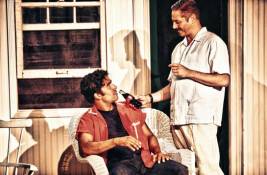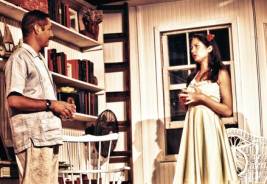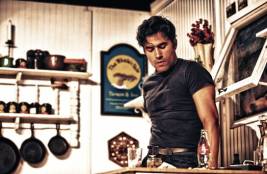
The year was 1947 and Tennessee Williams, still basking in the success of his New York Drama Critics Circle Award-winning The Glass Menagerie, was hoping to avoid a sophomore jinx with his upcoming A Streetcar Named Desire. Elia Kazan was set to direct, and Jessica Tandy to star as Blanche DuBois, but as yet no one had been cast in the pivotal role of Stanley Kowalski. Producer Irene Selznick was batting for John Garfield, but Williams had his doubts that the film star was right for the part. Then, according to Wikipedia, a virtually unknown actor named Marlon Brando “was given car fare to Tennessee Williams’ home in Provincetown, Massachusetts, where he not only gave a sensational reading, but did some house repairs as well.” Oh, and he got the part.
Playwright Gregg Ostrin has taken this bit of theatrical legend and imagined that very first meeting between 36-year-old Tennessee and 23-year-old Marlon in his enthralling new comedy-drama Kowalski, one which allows us for ninety real-time minutes to be flies on the walls of Williams’ Provincetown vacation cottage at that first encounter, one that changed the history of theater—and acting—forever.
But first we are introduced to two other central figures in the life of Tom “Tennessee” Williams (Curt Bonnem). They are his bosom buddy Margo Jones (Kimberly Stanphill), co-director of The Glass Menagerie, and Pancho Rodriguez (Anthony Rey Perez), his Texas-born Latino lover, said to have been the inspiration for Stanley Kowalski.
Sparks are already flying (and whiskies being guzzled) long before Brando (Ignacio Serricchio) shows up at Williams’ doorstep. Tom has had to explain to Margo that she’s been passed over as Streetcar director in favor of hot property Kazan, news which seems more like betrayal than business to the illustrious Miss Jones. Meanwhile, a jealous Pancho is once again raging about Tom’s neglect and threatening an evening of debauchery not to include his arrogant, self-centered lover. And if all this weren’t already enough, the toilet is stopped up and the lights keep going off.
Margo and Pancho head off for town, leaving Tom alone to stew in his own juices, and when the playwright leaves the living room briefly unattended, Marlon Brando makes his entrance.
Assuming that the studly young stranger is an intruder, Williams grabs a handy rolling pin to attack his would-be assailant. Though Marlon soon manages to convince his host that he has come only with the best of intentions, Tom is none too pleased that a) Brando is three days late for his audition and b) he’s way too young for the part as written. Unfazed, Marlon makes himself useful a la Stanley Kowalski by fixing both toilet and fuse box.
Over the next three-quarters of an hour or so, Williams and Brando engage in a verbal, physical, and subtly sexual cat-and-mouse game not unlike Stanley’s and Blanche’s in Streetcar, and it soon becomes clear to us that Brando is Kowalski, if only the playwright could see what’s right in front of his eyes.
Then, at the height of dramatic and sexual tension, a brand new character pops up at Williams’ door. She is Jo (Sasha Higgins), Marlon’s dumb bunny of a girlfriend with a Bronx accent so thick you’d need a steak knife to cut it, an adoration for Williams that can hardly be feigned, and such innate sweetness that even cynical Tennessee cannot fail to be charmed. Just imagine how Marlon reacts when Williams offers Jo the chance to read for Stella, having thus far denied young Brando his own audition for Stanley.
History tells us that Marlon Brando got the part on both stage and screen, that he went on to become one of our greatest stars, and that he revolutionized the field of acting in ways that remain relevant to this day. None of this would have happened, of course, without the hour and a half that Kowalski imagines so ingeniously.
You don’t have to be a Tennessee Williams fan or familiar with either his career or Brando’s to enjoy Kowalski, but those who’ve followed either of their lives will particularly relish this chance to spy on one of theatrical history’s truly pivotal moments.
Playwright Ostrin doesn’t burden us with huge chunks of biographical information, though we do learn about Williams’ tragic real-life sister, the model for The Glass Menagerie’s Laura, about his abusive father and dysfunctional family life, one mirrored in Brando’s own troubled childhood and adolescence. Certain expository lines of dialog are clearly there to fill us in with important bits of information, and jokes like the one about how exorbitantly high Broadway ticket prices are at $6.00 are there to make 2011 audiences laugh nostalgically, whether they’d actually have been said or not.
Still, it matters not a whit that what we see and hear in Kowalski may well be far different from what actually was said and done on that July night. Kowalski makes for great theater, pure and simple, particularly as brought to life by an all-around sensational cast under Rick Shaw’s incisive direction.
Bonnem has played Tennessee Williams before, but never in a play as cleverly written and downright enthralling as this, and the talented actor is out-and-out brilliant in the role, a superbly multi-faceted blend of bravado, insecurity, ego, and vulnerability. Bonnem gives us a Tennessee that can charm you one minute and drive you bananas the next, just as he must have done on a daily basis with Margo and Pancho.
As for Serricchio’s Marlon Brando, he may look nothing at all like the real deal, but he convinces us within seconds that he is the sexy, mumbling, magnetic, infuriating, irresistible man who ignited the screen so inextinguishably in the early 1950s.
Together, Bonnem and Serricchio burn up the stage hotter than it’s been in a good long while.
As Jo, Higgins takes what appears at first to be just another bimbo role and makes her the heart and conscience of Kowalski in a multilayered performance that so dazzles and delights that you wish Estrin would write a play just about Jo.
Stanphill and Perez provide bang-up support as a pair of couldn’t-be-more-different Texans, Stanphill giving Margo Lone Star State warmth, and as for Perez, can you say charismatic and caliente?
As an added note, each of the five characters speaks in a spot-on accent not his or her own. (I’ll leave you to guess who’s actually from England.)
Rand Sagers has designed and decorated a Provincetown cottage to 1947 perfection, one which Yana Shif, Krystal Maughan, and Colynn Schmitt have lit to fine effect. Kudos to Shep Stern and Sternworld Prods. for their music editing and sound design.
Kowalski is produced by Rick Shaw and Shari Shaw. Ally Zonsius is associate producer. Shif is stage manager.
Now in its third month of an extended run, Kowalski is not only a guaranteed crowd-pleaser; it will likely send you home on a quest to learn more about Williams, Brand, Margo Jones, and all the rest. And don’t be surprised if you find yourself putting A Streetcar Named Desire at the top of your Netflix queue.
The Two Roads Theatre, 4348 Tujunga Blvd., Studio City.
www.tworoadstheater.com
–Steven Stanley
September 4, 2011
Photos: Ricardo Mamood-Vega






 Since 2007, Steven Stanley's StageSceneLA.com has spotlighted the best in Southern California theater via reviews, interviews, and its annual StageSceneLA Scenies.
Since 2007, Steven Stanley's StageSceneLA.com has spotlighted the best in Southern California theater via reviews, interviews, and its annual StageSceneLA Scenies.







 COPYRIGHT 2024 STEVEN STANLEY :: DESIGN BY
COPYRIGHT 2024 STEVEN STANLEY :: DESIGN BY